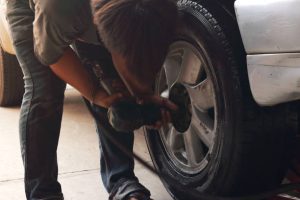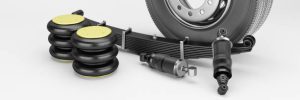In addition, air suspension might be used in place of coil springs or leaf springs, with polyurethane and rubber airbags. The bags are inflated to a specific pressure by a compressor to make them act like springs. Hydropneumatic suspension is different from air suspension in that it uses pressured air rather than pressurized liquid.
What Does an Air Suspension System Do?
Sports suspensions occasionally include an air suspension system as well, however air suspension is typically employed to provide a smooth and consistent driving quality. Similarly, in heavier vehicle applications, such as trucks, tractor-trailers, passenger buses, and even passenger trains, air suspension takes the place of a traditional steel spring suspension.
Electronically Controlled Air Suspension: What Is It?
A few crucial elements:
Each of the car’s wheels has heavy-duty air springs made of vulcanized rubber.
Under the hood or in the trunk of the car, an air compressor
Using a system of solenoids, valves, and o-rings, valve blocks direct air from the storage reservoir to the four springs.
Air springs that distribute air flow throughout the suspension system are connected by air pipes to a storage tank.
Advantages and Disadvantages of Air Suspension Systems
The air suspension market had a total market value of about $4.3 million at the end of 2017, according to Future Marketing Insights. Therefore, the advantages of an air suspension system, whether manual or electronic, can significantly enhance the ride of the car. Here are a few advantages of air suspension:
More driver comfort as a result of less road discomfort and fatigue-causing noise, harshness, and vibration
Lessening of harshness and vibration from heavy-duty driving results in less wear and tear on the suspension system.
Because the air suspension system’s components don’t experience as much vibration, trailers using it last longer.
When the truck is empty, air suspension lessens the tendency for it to bounce over rougher roads and terrain.
Depending on the load weight and the speed of the vehicle, air suspension raises the ride height.
Higher corner speeds because air suspension is more compatible with the road’s surface
Trucks and trailers with air suspension have greater transport capacity because it improves grip and levels the suspension as a whole. The feel of an air suspension system may also be changed, giving drivers the option of a softer ride for cruising down the highway or a rougher ride for better handling on winding, challenging roads.

Air suspension provides greater consistency and maintains all wheels level when towing heavy loads. Trucks are kept level from side to side by the air suspension system, particularly when the cargo is challenging to level. Because of this, there is less body roll when doing turns and curves.
Driving Tests New Zealand lists a few disadvantages of an air suspension system in addition to its advantages. These are a few of the drawbacks that so-and-so lists:
- An air suspension system can occasionally cost three times as much to fix as a leaf suspension system over the course of ten years, in addition to the initial costs associated with purchasing and installing one.
- Fuel costs for compressors that run infrequently to push air to the proper pressure.
- Because air suspension is heavier than leaf suspension, fuel efficiency may suffer.
- The susceptibility of an air suspension system to air leaks can lead to faults
- The mechanical problems that air suspension systems may be prone to are the origin of some of its disadvantages.
It is not uncommon to see air suspension systems installed in vehicles by owners who enjoy having more control over the appearance and performance of their vehicle. So, is this alteration appropriate for daily driving or just for special occasions? Read these suggestions for using air suspension in your everyday car if you’re debating the change.
Get Ready for Winter
Air suspension is a year-round technique. During the winter, it’s imperative to make sure nothing freezes in your air tank. Condensation that has built up in your system over time may cause this. Fortunately, installing a water trap will solve this problem completely. For instance, our aftermarket air suspension parts have water traps that may collect debris and water droplets to keep your airlines clean.
Get Your Ride Ready
The best advice for using air suspension on your daily car is to keep in mind your typical driving circumstances. This advice is valuable because ride height does not offer as much control as air suspension.
So you can alter your ride to suit whether you’re travelling on smooth or bumpy roads. To put it simply, air suspension systems should be taken into consideration if you like to customize your car to your specific tastes.
Don’t Forget To Empty The Air Tank
Recall the water trap we spoke of earlier? However, even though it will be quite beneficial, it won’t make your system maintenance-free. The trap helps you control the problem, since the moisture that is amassing in the air tank needs to go somewhere.

Enter your air suspension once a month to drain the air tank of any dampness. Although it is especially important to watch for condensation in the winter because of the possibility of freezing, moisture can accumulate at any time of the year. Fortunately, with these hints at your disposal, you can keep your air suspension operating efficiently and effectively.
